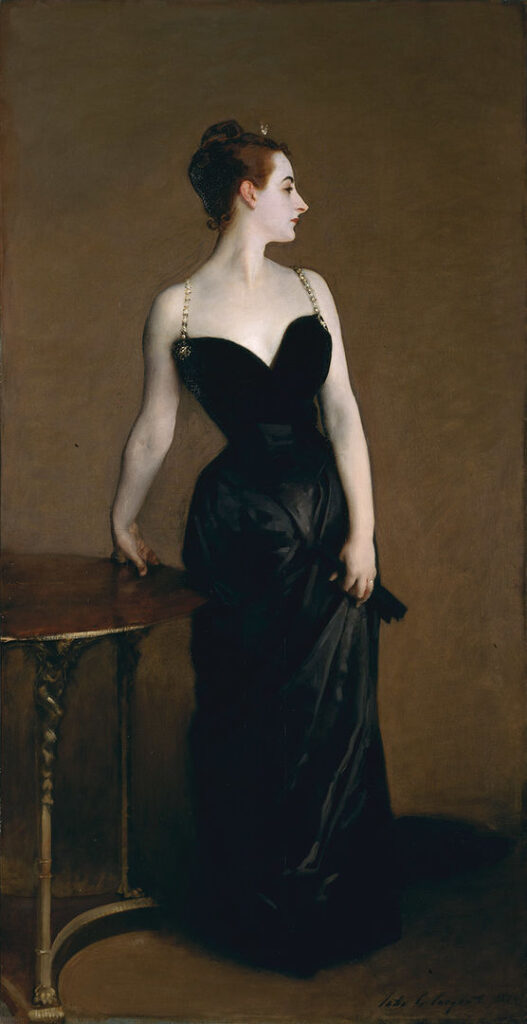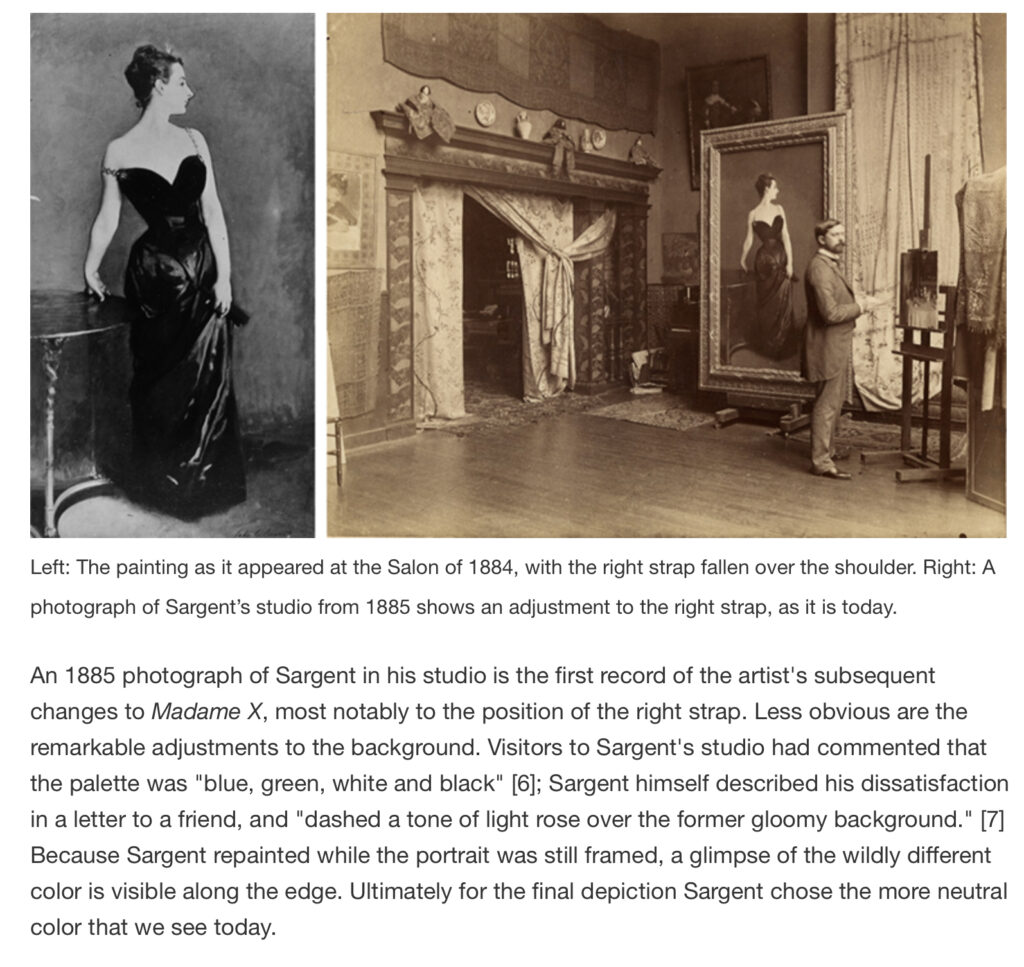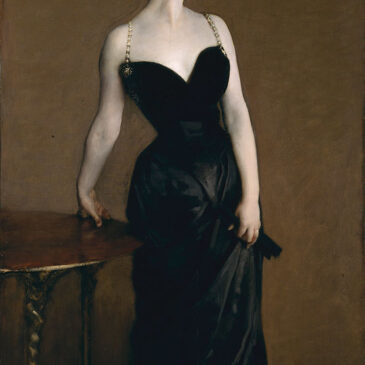“Madame X” is a famed portrait by John Singer Sargent, painted in 1884. The artwork depicts Virginie Amélie Avegno Gautreau, an American-born Parisian socialite known for her beauty and unique style. Though Sargent intended the portrait to elevate his artistic reputation in Paris, it instead became one of the most controversial works of the 19th century. Today, “Madame X” is celebrated for its technical brilliance and its pivotal role in Sargent’s career and in the art world at large. Here is an overview of the painting, its reception, and its lasting impact.
Background of the Painting
John Singer Sargent was an American expatriate artist living in Paris when he painted “Madame X.” Gautreau was well-known in Parisian society for her distinctive beauty, marked by pale skin, dark hair, and a statuesque figure. Sargent admired her striking appearance and sought her out as a subject, hoping to create a portrait that would make waves in the Parisian art world and establish him as a leading portraitist. Gautreau was reluctant initially, but she eventually agreed to sit for him, possibly enticed by the promise of an iconic portrayal.
Sargent worked painstakingly to create a powerful image of Gautreau, portraying her in a sleek, black satin dress with jeweled straps and a daringly low neckline. The composition emphasizes her long neck, pale skin, and confident stance, blending elements of elegance and sensuality. Originally, Sargent painted one of the dress straps hanging off her shoulder—a detail he later altered due to the painting’s controversial reception.

Scandal at the Paris Salon
Sargent exhibited “Madame X” at the Paris Salon of 1884, an event where artists displayed their work for public and critical review. Rather than the acclaim he hoped for, Sargent faced severe criticism. The bold depiction of Gautreau’s exposed shoulder and Sargent’s daring portrayal were considered indecorous and even scandalous in the conservative art scene of the time. Critics described the image as vulgar, and even Gautreau’s family was deeply embarrassed by the negative attention it brought. Under pressure, Sargent repainted the strap so that it rested on her shoulder, mitigating some of the perceived impropriety but leaving the portrait still distinctive.
The public’s reaction to “Madame X” nearly derailed Sargent’s career in Paris. However, he used this setback as an opportunity to move to London, where he found greater success as a portrait artist, eventually earning international renown.
Artistic Techniques and Style
“Madame X” exemplifies Sargent’s technical prowess, particularly his mastery of light, shadow, and texture. The interplay of Gautreau’s pale skin against the black dress highlights her complexion, creating an almost marble-like effect. Sargent’s brushwork, especially in her face and arms, demonstrates his ability to capture lifelike textures, while the bold, simple background emphasizes the stark elegance of his subject. Sargent’s portrayal strikes a careful balance between realism and idealization, a style that became characteristic of his portrait work.
Sargent’s choice to paint Gautreau in profile rather than frontally reflects influences from classical portraiture, especially from Roman statues, which often emphasize the subject’s profile to convey a sense of nobility and elegance. This classical approach contrasts sharply with the modernity of Gautreau’s appearance, particularly her bold dress and confident posture, underscoring Sargent’s innovative blend of traditional and contemporary elements.

Fashion and her Black Dress
John Singer Sargent’s 1884 portrait “Madame X” is not only celebrated for its technical brilliance but also for its powerful depiction of the fashion and style of its subject, Virginie Amélie Avegno Gautreau. Gautreau’s daring choice of dress and Sargent’s artistic interpretation of it became central to the painting’s initial controversy and later acclaim. The black satin gown, which clings to her figure, is a bold, almost avant-garde choice for the period, reflecting both Gautreau’s self-assured personality and her standing in Parisian high society.
The dress itself is a masterpiece of design and texture, expertly painted by Sargent to reflect its luxurious satin material. The deep black hue and the gown’s fitted silhouette create a stark contrast with Gautreau’s pale skin, enhancing her striking profile and adding an almost sculptural quality to her form. This high-contrast color scheme emphasizes the sinuous line of her body, making Gautreau appear statuesque and elegantly imposing. The dress’s thin jeweled straps, which seem to barely hold the gown in place, were a particularly shocking element at the time, as they pushed the boundaries of what was considered appropriate attire for women of Gautreau’s social class. This detail contributed significantly to the painting’s scandalous reception, as it exuded a modern, provocative sensuality.
The gown also speaks to Gautreau’s status as a trendsetter in Paris. Known for her unique beauty and daring style, she had long captivated the Parisian elite, often experimenting with fashion and makeup in ways that distinguished her from other women of her time. Her makeup—a faintly powdered face and her signature dyed hair—added to the sense of artifice and self-fashioning, which was both admired and criticized. The dress in “Madame X,” with its minimalist elegance, lack of embellishment, and fitted design, hints at the beginning of a shift in women’s fashion toward more figure-revealing and structured silhouettes, which would gain popularity in the years that followed.
Beyond its aesthetic qualities, Gautreau’s dress and her confident posture encapsulate a boldness that was often suppressed in women of her era. By portraying her in this daring attire, Sargent highlighted not only Gautreau’s beauty but also her independence and defiance of societal norms. This choice reflects broader themes in 19th-century art, as artists and subjects alike began exploring new forms of self-expression and identity. Today, “Madame X” is seen as an artistic bridge between traditional portraiture and the emerging modern attitudes that allowed for greater individuality in fashion and style.
Legacy and Impact
Despite its initially negative reception, “Madame X” is now hailed as one of Sargent’s masterpieces and a key work in late 19th-century portraiture. The painting eventually found a home in the United States when Sargent sold it to the Metropolitan Museum of Art in New York in 1916, where it remains today. Its provocative elegance and technical mastery continue to captivate viewers, and “Madame X” has inspired many artists and writers alike, serving as a symbol of both beauty and scandal.
The scandal surrounding “Madame X” also highlights the period’s shifting attitudes toward women’s independence and self-expression. Gautreau’s choice to present herself as a bold, sophisticated figure and Sargent’s unapologetic portrayal can be seen as reflections of the cultural changes taking place in the late 19th century. Today, “Madame X” stands not only as an artistic achievement but as an emblem of defiance and the complex expectations placed on women in society.
Sources
- Fairbrother, Trevor. John Singer Sargent. New York: Harry N. Abrams, 1994.
- This book provides an in-depth look at Sargent’s life and works, including the impact of “Madame X” on his career.
- Kilmurray, Elaine, and Richard Ormond. John Singer Sargent: The Early Portraits. New Haven: Yale University Press, 1998.
- This scholarly source discusses the early part of Sargent’s career, providing context for his move from Paris to London following the reception of “Madame X.”
- Metropolitan Museum of Art. “Madame X (Madame Pierre Gautreau),” Metmuseum.org.
- This resource offers details on the history and technical aspects of the painting as part of the Met’s collection.
- Brock, Charles. “John Singer Sargent and Madame X.” National Gallery of Art Lecture, 2010.
- Brock’s lecture examines the cultural context and artistic choices Sargent made in “Madame X,” providing insights into the scandal it caused at the time.
“Madame X” endures as one of Sargent’s most celebrated works, embodying both the allure and challenges of portraiture in a rapidly modernizing world. Its history and style continue to spark interest among art lovers and scholars today.
Subscribe on social media and email list to get artsy and travel updates, as well as get 15% off the Shop (yes, we have a Creative Shop)!

